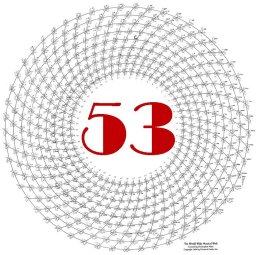Next Page: 12/2 – Dronal Harmony
First, second and third inversions
When the bass sings or plays the bottom note of a chord (such as the C of a C-Major triad), it is said to be in the “root position.” If the bass sounds the third instead (such as the E in a C Major chord), this is called the “first inversion.” If the bass sounds the fifth (such as the G in a C chord), this is the “second inversion.” If the bass sounds the seventh (such as Bb in a C7 chord), this is the “third inversion.”
Inversions do complex and interesting things with the overtones, and are a bit unstable harmonically. The individual notes of a chord in the root position send up overtones that blend nicely with the notes that are being sounded in the chord (such as the C-Major chord of C-E-G, where C’s overtones include E and G). But if you play that chord in the first inversion (E-G-C), the overtones of the bass note E are G# and B! The bass tone of the second inversion chord (G-C-E) creates the overtones B and D. Listen to the sounds of a C Major chord in its root, first and second inversions and you will hear that the inverted chords sound like they need resolution… and that’s their main value, to keep the ear following along and looking for resolution. Because the inversions are a bit unstable, rules are created to preserve the ear’s ability to follow your harmonic journey. You can break more rules when you’re in root position and still get away with it!….
If you would like to learn more about this chapter, “First, second and third inversions,” you can buy the entire book, The Grand Unified Theory of Music, in pdf form for $25 with hundreds of embedded musical examples of scales and chords from all over the world.
A free introduction to what The Grand Unified Theory of Music offers is on this website and includes both text and a few musical examples from each webpage. If you would like to learn more about this chapter and the full contents of this entire e-book, you can buy The Grand Unified Theory of Music for $25, with hundreds of embedded musical examples of scales and chords from all over the world — and ideas for how to set up your computer system —
HERE.
You’ll get a personalized password you can use to see the entire e-book. Inside the full book, you will also get a link to the complete pdf file of this e-book, which you can read on your Kindle or similar device. The links to the hundreds of mp3 sound files – the same ones you can hear on the website — will also be included. This is “Version 1.0” of The Grand Unified Theory of Music. Because it is an e-book, additions, corrections and improvements in the sound may be added at any time. The Grand Unified Theory of Music is Copyright © 2018 by Christopher Mohr. All rights reserved.
One person per password. Sharing this password with others is a violation of copyright. Do not allow others to use your password or link to the pdf file!
Next Page: 12/2 – Dronal Harmony
